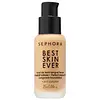What's inside
What's inside
 Key Ingredients
Key Ingredients

 Benefits
Benefits

 Concerns
Concerns

 Ingredients Side-by-side
Ingredients Side-by-side

Water
Skin ConditioningDimethicone
EmollientCI 77891
Cosmetic ColorantIsohexadecane
EmollientPEG-10 Dimethicone
Skin ConditioningPropanediol
SolventAlcohol
AntimicrobialCI 77492
Cosmetic ColorantDimethicone Crosspolymer
Emulsion StabilisingAcrylates Copolymer
Glycerin
HumectantMagnesium Sulfate
Synthetic Wax
AbrasiveCI 77491
Cosmetic ColorantHydroxyacetophenone
AntioxidantDisodium Stearoyl Glutamate
CleansingDisteardimonium Hectorite
StabilisingCI 77499
Cosmetic ColorantCaprylyl Glycol
EmollientSodium Hyaluronate
HumectantPropylene Carbonate
SolventAluminum Hydroxide
EmollientHydrolyzed Algin
Helianthus Annuus Seed Oil
EmollientPhenethyl Alcohol
MaskingSodium Carrageenan
Emulsion StabilisingGlyceryl Stearate Citrate
EmollientTocopherol
AntioxidantAscorbyl Tetraisopalmitate
AntioxidantBeta-Sitosterol
Emulsion StabilisingSqualene
EmollientMaris Sal
Skin ConditioningWater, Dimethicone, CI 77891, Isohexadecane, PEG-10 Dimethicone, Propanediol, Alcohol, CI 77492, Dimethicone Crosspolymer, Acrylates Copolymer, Glycerin, Magnesium Sulfate, Synthetic Wax, CI 77491, Hydroxyacetophenone, Disodium Stearoyl Glutamate, Disteardimonium Hectorite, CI 77499, Caprylyl Glycol, Sodium Hyaluronate, Propylene Carbonate, Aluminum Hydroxide, Hydrolyzed Algin, Helianthus Annuus Seed Oil, Phenethyl Alcohol, Sodium Carrageenan, Glyceryl Stearate Citrate, Tocopherol, Ascorbyl Tetraisopalmitate, Beta-Sitosterol, Squalene, Maris Sal
Water
Skin ConditioningDimethicone
EmollientIsododecane
EmollientCyclopentasiloxane
EmollientPhenyl Trimethicone
Skin ConditioningTitanium Dioxide
Cosmetic ColorantButylene Glycol
HumectantPropylene Glycol
HumectantPEG-9 Dimethicone
Skin ConditioningPEG-9 Polydimethylsiloxyethyl Dimethicone
EmulsifyingSodium Chloride
MaskingSimmondsia Chinensis Seed Oil
EmollientTribehenin
EmollientTalc
AbrasiveTriethoxycaprylylsilane
Silica Dimethyl Silylate
EmollientTrimethoxycaprylylsilane
SmoothingAlcohol Denat.
AntimicrobialDisodium EDTA
Panthenol
Skin ConditioningDisteardimonium Hectorite
StabilisingEthylhexylglycerin
Skin ConditioningTocopheryl Acetate
AntioxidantPhenoxyethanol
PreservativeDehydroacetic Acid
PreservativeBenzoic Acid
MaskingCI 77491
Cosmetic ColorantCI 77492
Cosmetic ColorantCI 77499
Cosmetic ColorantWater, Dimethicone, Isododecane, Cyclopentasiloxane, Phenyl Trimethicone, Titanium Dioxide, Butylene Glycol, Propylene Glycol, PEG-9 Dimethicone, PEG-9 Polydimethylsiloxyethyl Dimethicone, Sodium Chloride, Simmondsia Chinensis Seed Oil, Tribehenin, Talc, Triethoxycaprylylsilane, Silica Dimethyl Silylate, Trimethoxycaprylylsilane, Alcohol Denat., Disodium EDTA, Panthenol, Disteardimonium Hectorite, Ethylhexylglycerin, Tocopheryl Acetate, Phenoxyethanol, Dehydroacetic Acid, Benzoic Acid, CI 77491, CI 77492, CI 77499
 Reviews
Reviews

Ingredients Explained
These ingredients are found in both products.
Ingredients higher up in an ingredient list are typically present in a larger amount.
Ci 77491 is also hydrated iron III oxide. It's sole purpose is to give a red/pink hue to products.
Iron III oxides are classified as inorganic chemicals for coloring.
Synthetically created Ci 77491 is considered safer than those naturally found. This is because the synthetically created version may contain less impurities. Iron oxides are generally non-toxic and non-allergenic.
Learn more about CI 77491Ci 77492 is also hydrated iron III oxide. It's sole purpose is to give a yellow hue to products.
Iron III oxides are classified as inorganic chemicals for coloring.
Synthetically created Ci 77492 is considered safer than those naturally found. This is because the synthetically created version may contain less impurities. Iron oxides are generally non-toxic and non-allergenic.
Learn more about CI 77492Ci 77499 is also hydrated iron III oxide. It is created from mixing red and black iron oxides. This helps give shades of darkness to a product.
Iron III oxides are classified as inorganic chemicals for coloring.
Dimethicone is a type of synthetic silicone created from natural materials such as quartz.
What it does:
Dimethicone comes in different viscosities:
Depending on the viscosity, dimethicone has different properties.
Ingredients lists don't always show which type is used, so we recommend reaching out to the brand if you have questions about the viscosity.
This ingredient is unlikely to cause irritation because it does not get absorbed into skin. However, people with silicone allergies should be careful about using this ingredient.
Note: Dimethicone may contribute to pilling. This is because it is not oil or water soluble, so pilling may occur when layered with products. When mixed with heavy oils in a formula, the outcome is also quite greasy.
Learn more about DimethiconeDisteardimonium Hectorite comes from the clay mineral named hectorite. It is used to add thickness to a product.
It can also help stabilize a product by helping to disperse other ingredients.
Hectorite is a rare, white clay mineral.
Learn more about Disteardimonium HectoriteWater. It's the most common cosmetic ingredient of all. You'll usually see it at the top of ingredient lists, meaning that it makes up the largest part of the product.
So why is it so popular? Water most often acts as a solvent - this means that it helps dissolve other ingredients into the formulation.
You'll also recognize water as that liquid we all need to stay alive. If you see this, drink a glass of water. Stay hydrated!
Learn more about Water